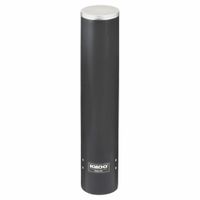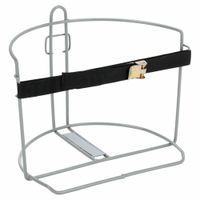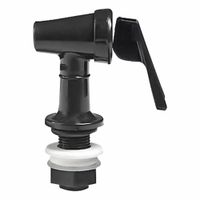Call +(254) 703 030 000 / 751 483 999 / 721 704 777
- Home
- Safety
- Hydration Products
- Beverage Dispensing Coolers Accessories
.....Read More
Frequently Asked Questions
What is the best way to clean a beverage-dispensing cooler?
To clean a beverage-dispensing cooler effectively, follow these steps:
1. **Unplug and Empty**: Disconnect the cooler from the power source. Remove all beverages and any detachable parts like drip trays and nozzles.
2. **Disassemble**: Take apart removable components such as taps, nozzles, and hoses. Refer to the manufacturer's manual for guidance.
3. **Soak and Scrub**: Soak the detachable parts in warm, soapy water. Use a brush to scrub away any residue or buildup. Rinse thoroughly with clean water.
4. **Clean Interior**: Wipe the interior surfaces with a solution of warm water and mild detergent. Use a soft cloth or sponge to avoid scratching. Pay special attention to corners and crevices.
5. **Sanitize**: Prepare a sanitizing solution using one tablespoon of unscented bleach per gallon of water. Wipe down all interior surfaces and detachable parts with this solution. Allow it to air dry.
6. **Clean Exterior**: Wipe the exterior with a damp cloth and mild detergent. Avoid abrasive cleaners that can damage the finish.
7. **Flush System**: Reassemble the cooler and fill the reservoir with clean water. Run the water through the dispensing system to flush out any remaining cleaning solution.
8. **Dry and Reassemble**: Allow all parts to dry completely before reassembling. Ensure all components are securely attached.
9. **Restock and Plug In**: Once dry, restock the cooler with beverages and plug it back into the power source.
10. **Regular Maintenance**: Establish a regular cleaning schedule to prevent buildup and ensure the cooler operates efficiently.
By following these steps, you ensure the cooler remains hygienic and functions optimally.
How do I choose the right size beverage-dispensing cooler for my needs?
To choose the right size beverage-dispensing cooler, consider the following factors:
1. **Capacity Needs**: Determine the volume of beverages you need to store and dispense. Consider the number of guests or customers you typically serve and the duration of the event or service period. For large gatherings or high-traffic areas, opt for a cooler with a larger capacity.
2. **Space Availability**: Measure the space where you plan to place the cooler. Ensure the dimensions of the cooler fit comfortably within the designated area, allowing for ventilation and accessibility.
3. **Portability**: If you need to move the cooler frequently, consider a model with wheels or handles. Smaller, lightweight coolers are easier to transport, while larger ones may require more effort.
4. **Type of Beverages**: Different beverages may require specific storage conditions. For example, kegs need more space and specific fittings, while cans and bottles can be stacked. Choose a cooler that accommodates the type of beverages you plan to dispense.
5. **Cooling Technology**: Evaluate the cooling mechanism. Some coolers use ice, while others have built-in refrigeration. Electric coolers offer consistent temperature control, which is crucial for certain beverages like beer.
6. **Budget**: Set a budget that balances your needs with available features. Larger, more advanced coolers typically cost more, so prioritize features that are essential for your use.
7. **Frequency of Use**: For occasional use, a smaller, less expensive cooler may suffice. For regular use, invest in a durable, high-capacity model.
8. **Additional Features**: Consider features like adjustable shelves, multiple taps, or digital temperature controls, which can enhance functionality and convenience.
By assessing these factors, you can select a beverage-dispensing cooler that meets your specific requirements efficiently.
What are the most common replacement parts for beverage-dispensing coolers?
The most common replacement parts for beverage-dispensing coolers include:
1. **Compressor**: This is the heart of the cooling system, responsible for circulating refrigerant and maintaining the desired temperature. It can wear out over time due to continuous operation.
2. **Thermostat**: This component regulates the temperature inside the cooler. A faulty thermostat can lead to improper cooling or freezing.
3. **Condenser and Evaporator Coils**: These coils are essential for heat exchange. They can become dirty or damaged, affecting the cooler's efficiency.
4. **Fans and Motors**: These are crucial for air circulation within the cooler. Fans can break or motors can burn out, leading to inadequate cooling.
5. **Door Seals/Gaskets**: These ensure the cooler is airtight. Worn or damaged seals can cause air leaks, leading to energy inefficiency and temperature fluctuations.
6. **Water Valves and Pumps**: In coolers with water dispensing features, these components control the flow of water. They can become clogged or fail, affecting water dispensing.
7. **Dispensing Nozzles and Taps**: These are subject to wear and tear due to frequent use and may need replacement to ensure proper beverage flow.
8. **Filters**: Water and air filters need regular replacement to maintain hygiene and efficiency in the cooling and dispensing process.
9. **Control Boards**: These electronic components manage the cooler's operations. Malfunctions can disrupt the entire system.
10. **Shelving and Racks**: These can become damaged or corroded over time, requiring replacement to maintain proper storage and organization.
Regular maintenance and timely replacement of these parts can extend the lifespan of beverage-dispensing coolers and ensure optimal performance.
How do I install a cup dispenser on a beverage-dispensing cooler?
1. **Choose the Right Dispenser**: Select a cup dispenser compatible with your cooler and the cup sizes you intend to use.
2. **Gather Tools and Materials**: You may need a screwdriver, drill, screws, adhesive, and a level.
3. **Determine Placement**: Decide where on the cooler you want to install the dispenser. Ensure it’s easily accessible and doesn’t obstruct the cooler’s operation.
4. **Mark the Location**: Use a pencil to mark where the dispenser will be mounted. Ensure it’s level.
5. **Prepare the Surface**: Clean the area where the dispenser will be attached to ensure a strong bond if using adhesive.
6. **Drill Holes (if necessary)**: If the dispenser requires screws, drill pilot holes at the marked locations. Be cautious not to damage the cooler.
7. **Attach the Dispenser**:
- **Screw Mounting**: Align the dispenser with the drilled holes and secure it using screws.
- **Adhesive Mounting**: Apply adhesive to the back of the dispenser and press it firmly against the cooler. Hold it in place until the adhesive sets.
8. **Check Alignment**: Use a level to ensure the dispenser is straight.
9. **Load Cups**: Insert cups into the dispenser, ensuring they fit properly and dispense smoothly.
10. **Test the Dispenser**: Pull a cup to ensure it dispenses correctly and the installation is secure.
11. **Adjust if Necessary**: If the dispenser is not functioning properly, adjust its position or check for obstructions.
12. **Regular Maintenance**: Periodically check the dispenser for wear and ensure it remains securely attached.
What materials are beverage-dispensing coolers typically made from?
Beverage-dispensing coolers are typically constructed from a combination of materials designed to ensure durability, insulation, and hygiene. The primary materials include:
1. **Stainless Steel**: Often used for the exterior and interior surfaces, stainless steel is favored for its durability, resistance to corrosion, and ease of cleaning. It provides a sleek appearance and is commonly used in commercial settings.
2. **Plastic**: High-density polyethylene (HDPE) or other food-grade plastics are frequently used for components like drip trays, lids, and some interior parts. These materials are lightweight, resistant to impact, and easy to mold into various shapes.
3. **Insulation Foam**: Polyurethane foam is commonly used for insulation within the walls of the cooler. This material is excellent for maintaining the internal temperature, ensuring beverages stay cold for extended periods.
4. **Glass**: In models with transparent doors or windows, tempered glass is used. It allows for visibility of the contents while providing strength and safety.
5. **Rubber and Silicone**: These materials are used for gaskets and seals to ensure airtight closures, preventing cold air from escaping and warm air from entering.
6. **Aluminum**: Sometimes used for internal shelving or structural components due to its lightweight and corrosion-resistant properties.
7. **Copper or Aluminum Tubing**: Used in the refrigeration system for efficient heat exchange. Copper is preferred for its superior thermal conductivity, while aluminum is a cost-effective alternative.
These materials are selected to ensure the cooler is efficient, durable, and safe for food and beverage storage, meeting both commercial and consumer needs.
How do I prevent leaks in my beverage-dispensing cooler?
To prevent leaks in your beverage-dispensing cooler, follow these steps:
1. **Regular Inspection**: Frequently check the cooler for any signs of wear and tear, especially around seals, gaskets, and connections. Look for cracks, corrosion, or any loose fittings.
2. **Seal Maintenance**: Ensure that all seals and gaskets are intact and functioning properly. Replace any that are worn out or damaged to maintain a tight seal and prevent leaks.
3. **Proper Installation**: Ensure that all components, including hoses and fittings, are installed correctly. Use the appropriate tools and follow manufacturer guidelines to avoid improper connections that could lead to leaks.
4. **Tighten Connections**: Regularly check and tighten all connections, including those on hoses, taps, and valves. Loose connections are a common source of leaks.
5. **Use Quality Parts**: Invest in high-quality hoses, seals, and fittings. Cheaper components may not withstand pressure and temperature changes, leading to leaks.
6. **Temperature Control**: Maintain the cooler at the recommended temperature. Extreme temperatures can cause materials to expand or contract, leading to potential leaks.
7. **Pressure Regulation**: Ensure that the pressure within the system is within the recommended range. Excessive pressure can cause hoses and seals to fail.
8. **Clean Regularly**: Keep the cooler clean to prevent buildup of residue that can cause blockages or damage seals and gaskets.
9. **Professional Servicing**: Schedule regular maintenance with a professional technician to ensure all components are in good working order and to address any potential issues before they become serious.
10. **Emergency Kit**: Keep a repair kit handy with essential tools and spare parts to quickly address any leaks that may occur unexpectedly.
Are there any specific brands known for high-quality beverage-dispensing coolers?
Yes, several brands are renowned for producing high-quality beverage-dispensing coolers.
1. **True Manufacturing**: Known for their commercial-grade refrigeration products, True Manufacturing offers durable and efficient beverage coolers that are widely used in restaurants and bars.
2. **Beverage-Air**: This brand is recognized for its innovative designs and reliable performance. Beverage-Air coolers are popular in both commercial and residential settings for their energy efficiency and robust construction.
3. **Perlick**: Specializing in premium refrigeration solutions, Perlick offers high-end beverage coolers that are known for their sleek design and advanced cooling technology, making them a favorite in upscale bars and homes.
4. **Turbo Air**: Turbo Air is known for its eco-friendly and energy-efficient coolers. Their products are designed to maintain consistent temperatures, ensuring beverages are kept at optimal conditions.
5. **Danby**: For residential use, Danby offers a range of affordable yet high-quality beverage coolers. They are known for their compact designs and reliable performance, making them ideal for home bars and kitchens.
6. **U-Line**: U-Line is a leader in under-counter refrigeration, offering stylish and efficient beverage coolers that are perfect for both home and commercial use. Their products are known for their versatility and high-end features.
7. **EdgeStar**: EdgeStar provides a variety of beverage coolers that are praised for their affordability and functionality. They offer compact and full-size models suitable for different needs.
These brands are recognized for their commitment to quality, durability, and innovation in the beverage cooler industry, catering to a wide range of consumer needs from commercial establishments to home use.



